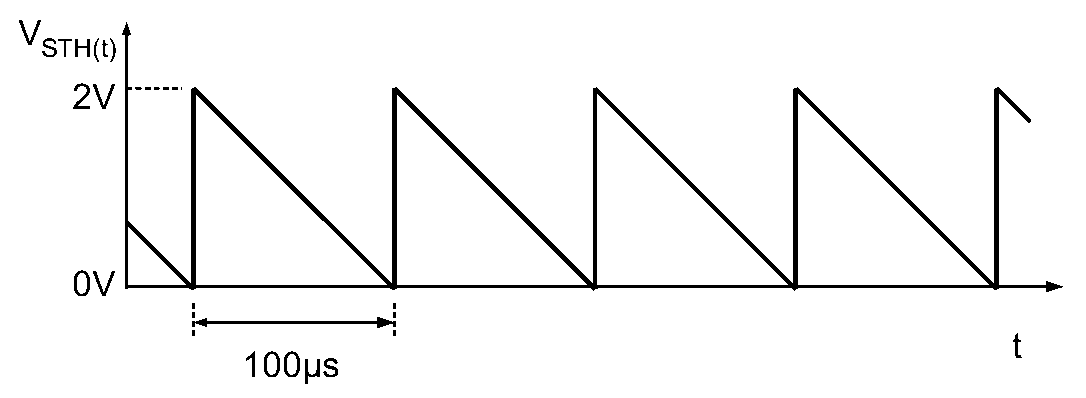This device is able to regulate brightness of 4 or more modern strong LEDs from 0% to 100%. In order to minimise power dissipation, its operation is based on the principle of varying the duty ratio of output LED currents, enabling small signal transistors to be used in its default configuration to control 200mW LEDs. By replacing output drivers with more powerfull components, circuit power handling cappability can be boosted up thousands of times...
Sawtooth generator
The hearth of the device is a sawtooth generator formed out of four operational amplifiers found in a single LM324 IC. The purpose of this relaxational oscillator is to generate voltage that linearly declines from +Vref to 0V inside each signal period. This periodic voltage is then used as a time reference by voltage comparators in the second part of the circuit, described on the next page, using which the duty ratio of each LED square wave current can be set very precisely.

Operational amplifier "A" works as a voltage follower, forming a stable low impedance reference voltage of exactly 2VDC at its output. This voltage is then used as a common circuit reference by all other subcircuits - a sawtooth generating stage ("B"), sawtooth triggers ("C" and "D") and all PWM voltage comparators that can be seen on the next page.
Amplifier "B" is a typical integrator. Its noninverting input takes 2V reference voltage from the "A" amplifier output. In order to equalise voltages at its inputs, which is the prime principle that all operational amplifier circuits are based on, amplifier "B" needs to induce constant current flow through resistor R0, so that the voltage drop over it is equal to VCC - VREF. Because input impedance at operational amplifier inverting and noninverting inputs is infinitely high, no current can flow eithen into or out of them. This means that amplifier "B" has to induce constant current flow through C0 cappacitor, equal to the necessary current flow through resistor R0. According to Maxwell equations, the only way of inducing constant current flow through a cappacitor is to linearly change the voltage difference between its electrodes in time. Having in mind the direction that constant current flows through R0 resistor, we conclude that "B" amplifier adjusts its output voltage so that it linearly decreases in time. The shape of this voltage is depicted in the next diagram.

Operational amplifiers "C" and "D" are used to periodically retrigger the integrator "B". If they were not in place, amplifier "B" would form a single negative linear voltage slope after powering the circuit on, stopping its operation after its output voltage reached 0V. But amplifier "C" monitors Vsth so that the moment this voltage becomes close to 0V, it causes a monostable multivibrator (amplifier "D") to activate a small signal MOSFET transistor Q1. It in turn shortcircuits the cappacitor C0, effectively retriggering the integrator "B" and causing its output voltage Vsth to sharply rise to 2Vref. Retriggering time is very short but it lasts long enough so that voltage across the cappacitor C0 is guaranteed to be reset to 0V at the beginning of the next integrating period.
With component and voltage values as given above, each period of the sawtooth wave lasts approximately 220Ás. In general, sawtooth period duration for the circuit given in the diagram can be estimated pretty accurately using the following reasoning:
I0 = VR0 / R0 = (VCC - VREF) / R0
I0 = C0 * (dVC0 / dt), dVC0 = VREF - 0 = VREF, dt = T0
=> I0 = C0 * (VREF / T0) .
Substituting this into the first formula, we get:
(VCC - VREF) / R0 = C0 * (VREF / T0)
=> (VCC - VREF) * T0 = VREF * R0 * C0
=> T0 = (VREF / (VCC - VREF)) * R0 * C0 .
Finally, because VCC = 5V and VREF = 2V:
Referesh frequency has been chosen to be this high so that LEDs can be used in photography - having in mind average exposure duration of 10ms or longer, it is guaranteed that at least 50 or so full PWM periods are captured during each exposure, meaning that color mix observed by the naked eye is accurately captured by the camera. If PWM periods were longer i.e. close to camera exposure time, there would exist a chance that "On" times of particular LEDs in relation to the total exposure time (as observed by the camera) would differ significantly from their averaged values (as observed by the photographer). That would lead to observable color distortions in photograps in comparison to the look of the same objects as seen directly by eye - how much distortions are generated would depend on the exact random moment the camera starts to expose its sensor with respect to the moment particular PWM pulses start... which means that color representation would be very inconsistent from one shot to the other.


